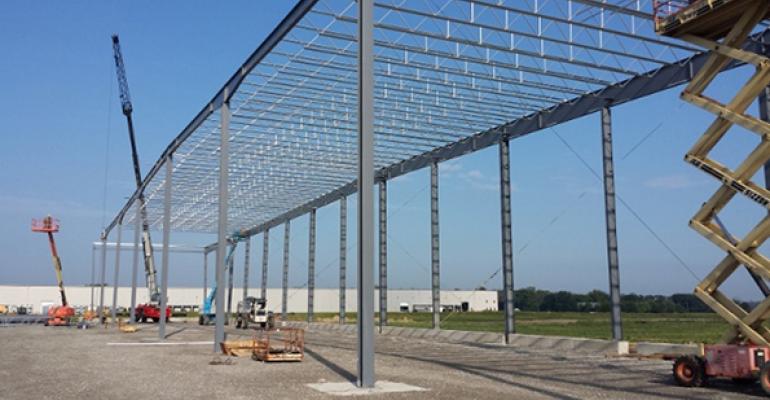Industrial construction has reached its highest level in this cycle.
Nearly 233 million sq. ft. of new industrial space was delivered to the market in 2017 and another 221.6 million was under construction at the end of the fourth quarter of 2017, with speculative projects accounting for nearly 75 percent of projects underway, according to the Industrial Outlook report for the fourth quarter of 2017 from real estate services firm JLL. Construction Monitor, which tracks permits pulled nationally for both commercial and residential projects, reports that developers so far this year have pulled permits for about 107.5 million sq. ft. of new industrial space.
Record low vacancy is driving new industrial development and keeping upward pressure on rents. Prologis, the country’s largest industrial developer, experienced rent growth of 19 percent last year, notes Adam Herrin, managing director with real estate capital intermediary HFF. Rent growth in the industrial sector is the big story right now, he says.
Despite this sector’s exemplary performance, it has become increasingly difficult for developers to secure construction loans from banks, which are the best source of financing in terms of cost, flexibility and size of loans, according to Steve Roth, vice chairman, debt and structured finance, with real estate services firm CBRE. He says that debt funds are expanding into this segment of the market, but are seeking to finance larger loans with “duration.” In addition, the cost of capital for debt funds is significantly more expensive than bank funding.
Due to a multitude of factors, banks have limited amount of capital allocated for speculative industrial construction. As a result, banks are more selective in making this type of loan than in the past, says Roth, noting that a project needs a sponsor with a strong banking relationship to secure construction financing. Cultivating a relationship with a bank can take up to two years, he says, pointing out that “banks look at the “pedigree of the developer.” This includes the developer’s market presence, integrity and track record.
Industrial buildings go up quickly, with delivery times of eight to 12 months. In today’s aggressive market, newly constructed building sell quickly, so loans are often paid off soon after the projects are completed. As a result, loan pricing has increased to compensate for the risk of financing speculative projects.
According to Herrin, much of the ground-up, speculative development is getting done through joint ventures. “We’re seeing lots of joint ventures with developers with a pulse on local markets, boots on the ground and the expertise to get projects entitled partnering with capital investors that are providing the majority of funding,” he says.
“There is flight to quality, so there appears to be a big appetite for ground-up,” he adds, noting that there are several sources of capital looking to invest in speculative industrial development because it provides the best yields.
Capital for speculative development is coming from various places, Herrin notes, including insurance companies and domestic pension advisors, as well as foreign pension funds and sovereign wealth funds out of Japan, China, Southeast Asia, Europe and Canada. Canadians are the biggest players, investing double the amount of any other foreign government. Germans are very active too, Herrin notes, explaining that since German government bonds are trading at extremely low rates, what looks like an aggressive cap rate to U.S. investors, looks like a good return to the Germans.
Roth notes, however, that foreign capital invested in U.S. projects is typically on the equity side, rather than debt.
On the acquisition side, “value-add is in vogue,” Herrin adds, explaining that from a cap rate standpoint, there can be a significant spread between value-add class-B and class-A assets—as much as 150 to 200 basis points. “Depending on the location and physical quality, older, vintage properties capitalization rates are in the 5.75 percent to 6.75 percent range, compared to the mid- to high-4s for class-A assets,” he says.
Value-add funds and private real estate investment funds like Blackstone’s newly formed B REIT are funding these types of acquisitions, according to Herrin.
But the biggest share of financing transactions currently handled by HFF involves re-capitalization deals due to still low interest rates. “Industrial owners are looking at the long term and may not want to sell or deploy capital into today’s aggressive industrial market,” Herrin says. “Securing new debt or bringing in a new equity partner provides cash to reinvest, while allowing them to retain ownership of the real estate, which bolsters their balance sheet and credit worthiness.”





